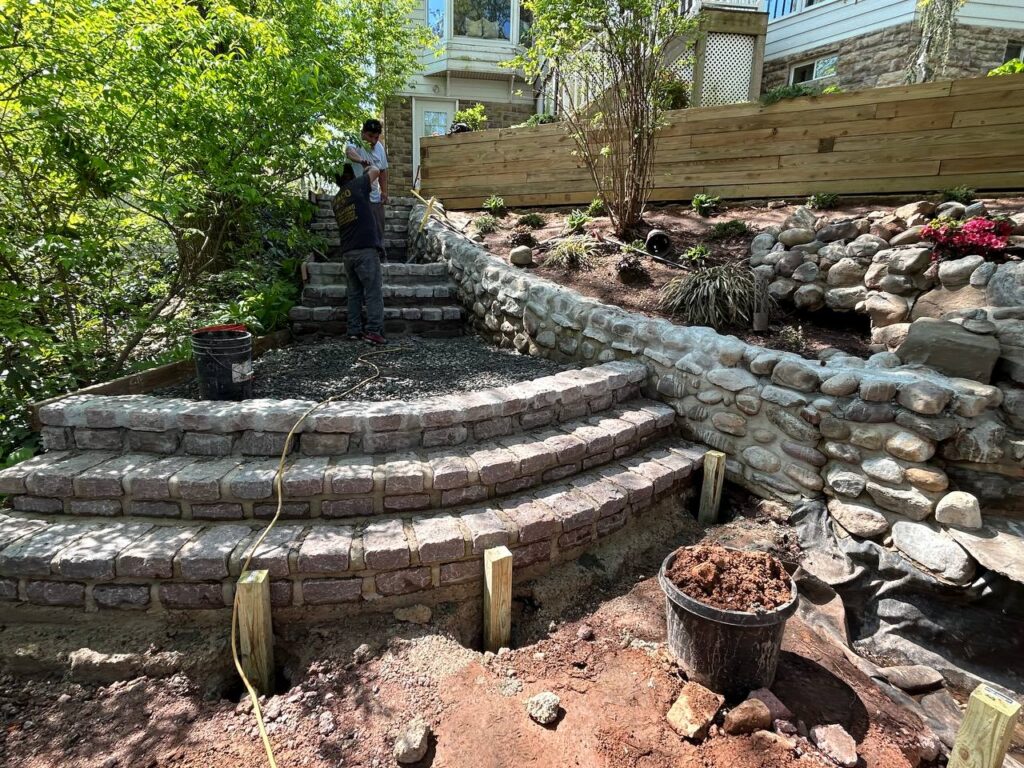Maintaining your retaining walls is crucial for ensuring their longevity, functionality, and aesthetic appeal. Regular upkeep can prevent costly repairs and structural issues. Here’s a step-by-step guide to help you properly maintain your retaining walls.
1. Inspect Your Retaining Walls Regularly
Regular inspections help identify problems early:
- Visual Check: Look for signs of damage, such as cracks, bulges, or leaning. Pay attention to the condition of the wall’s surface and the stability of its base.
- Drainage Issues: Ensure that drainage systems are functioning properly and that there’s no water pooling behind the wall, which can lead to erosion or structural failure.
2. Clean the Wall Surface
Keeping the surface clean helps maintain its appearance and prevent damage:
- Remove Debris: Clear leaves, dirt, and other debris from the wall and surrounding area. Accumulated debris can trap moisture and lead to deterioration.
- Wash the Wall: Use a mild detergent and water to clean the surface. For tougher stains, a pressure washer can be effective, but be careful not to damage the wall with too much pressure.
3. Check and Repair Drainage Systems
Proper drainage is essential for the stability of retaining walls:
- Inspect Drains: Check that weep holes, pipes, and drainage systems are clear and functioning correctly. Clogged drains can cause water buildup and pressure behind the wall.
- Clean and Repair: Remove any blockages and repair or replace damaged drainage components to ensure proper water flow.
4. Address Cracks and Damage
Repairing cracks and other damage promptly prevents further issues:
- Small Cracks: For minor cracks, use a masonry crack filler or caulk to seal them. Clean the crack area thoroughly before applying the filler.
- Large Cracks or Bulges: For significant damage, consult a professional. Structural issues may require more extensive repairs or reinforcement.

5. Monitor and Manage Vegetation
Vegetation can impact the stability and appearance of retaining walls:
- Trim Plants: Keep plants and vines trimmed away from the wall. Roots can undermine the wall’s stability and contribute to erosion.
- Replant Wisely: Choose plants with non-invasive root systems for areas near the wall. Ensure they don’t interfere with the wall’s drainage or structure.
6. Check for Erosion and Soil Shifts
Erosion and soil movement can affect the wall’s stability:
- Inspect Soil: Look for signs of erosion or shifting soil around the base of the wall. Erosion can lead to instability and damage.
- Repair Erosion: Address erosion issues by reinforcing the soil with additional landscaping or erosion control methods. This may include adding mulch, gravel, or planting ground cover.
7. Maintain the Wall’s Structural Integrity
Ensure the structural integrity of the retaining wall remains intact:
- Reinforce Weak Areas: If you notice any weak or unstable areas, consider reinforcing them with additional support or stabilization methods.
- Consult a Professional: For significant structural concerns, seek the expertise of a professional engineer or contractor to assess and address the issues.
8. Regularly Inspect and Maintain Surrounding Areas
The condition of the area around the wall also affects its maintenance:
- Surface Grading: Ensure that the area around the wall is properly graded to direct water away from the base. Proper grading helps prevent water accumulation and erosion.
- Maintain Landscaping: Keep the landscaping around the wall in good condition to avoid problems with soil erosion or water drainage.
9. Review and Update Maintenance Practices
Adjust your maintenance practices as needed:
- Evaluate Effectiveness: Periodically review the effectiveness of your maintenance routine. Adjust as needed based on the wall’s condition and any new issues that arise.
- Stay Informed: Keep up-to-date with best practices and recommendations for retaining wall maintenance. This helps ensure that your wall remains in optimal condition.
10. Plan for Long-Term Maintenance
Prepare for ongoing maintenance to extend the lifespan of your retaining wall:
- Schedule Regular Inspections: Set a schedule for regular inspections and maintenance tasks to keep the wall in good shape.
- Budget for Repairs: Allocate a budget for maintenance and repairs to address any issues promptly and prevent costly damage.
Proper maintenance of retaining walls is essential for preserving their functionality, stability, and visual appeal. By following these steps and addressing issues promptly, you can ensure that your retaining walls continue to enhance your property for years to come.

